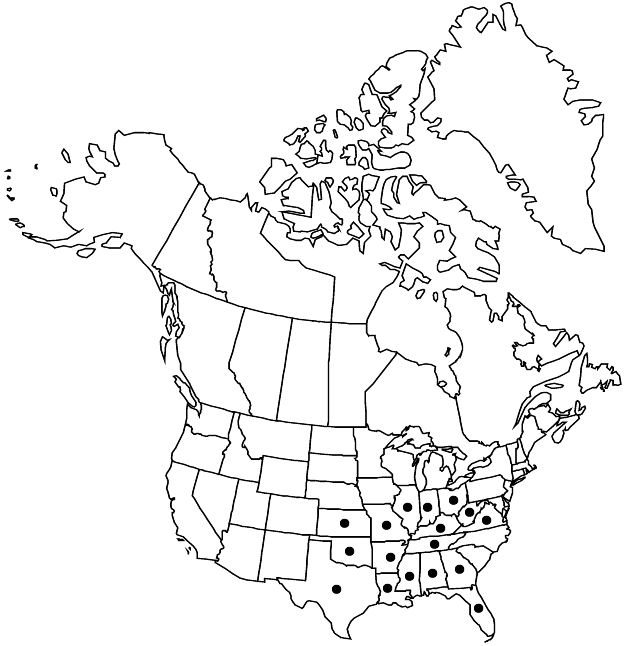Euphorbia humistrata
in A. Gray, Manual ed. 2, 386. 1856.
Herbs, annual, with taproot. Stems prostrate to ascending, usually mat-forming and rooting at nodes, 5–45 cm, sparsely to moderately villous to pilose (densely on young growth). Leaves opposite; stipules distinct, linear-subulate, often irregularly 2- or 3-lobed, 1–1.3 mm, sparsely villous to pilose; petiole 0.5–1.5 mm, sparsely to moderately villous to pilose; blade oblong-ovate to ovate-elliptic or oblong-elliptic, 4–18 × 2.5–8 mm, base strongly asymmetric, one side angled and other rounded to auriculate, margin on longer side serrulate, on shorter side subentire, apex rounded or broadly acute, abaxial surface pale grayish green, sparsely lanulose, adaxial surface usually with irregular reddish streak along midvein, usually glabrate, rarely sparsely lanulose; palmately veined at base, pinnate distally. Cyathia solitary at distal nodes; peduncle 0.1–0.6(–2) mm. Involucre obconic, 0.8–1 × 0.6–0.8 mm, sparsely villous to pilose; glands 4, green to yellow-green (turning pink with age), usually ± unequal, narrowly oblong, 0.1–0.2 × 0.2–0.5 mm; appendages white to reddish tinged, lunate, ± irregular and variable in shape, 0.1–0.3 × 0.2–1.5 mm, distal margin crenulate. Staminate flowers 2–5. Pistillate flowers: ovary short-sericeous; styles 0.5–0.8 mm, 2-fid 1/2 length. Capsules ovoid, well exserted from involucre at maturity, 1.3–1.5 × 1.2–1.6 mm, sparsely to moderately short-sericeous; columella 0.9–1.2 mm. Seeds white to light brown, oblong-ovoid, bluntly angular in cross section, 0.8–1.2 × 0.5–0.9 mm, smooth or papillate.
Phenology: Flowering and fruiting spring–late summer.
Habitat: Stream and river banks, gravel bars, floodplains, pond edges, disturbed fields, railroads, roadsides.
Elevation: 0–300 m.
Distribution

Ala., Ark., Fla., Ga., Ill., Ind., Kans., Ky., La., Miss., Mo., Ohio, Okla., Tenn., Tex., Va., W.Va.
Discussion
Euphorbia humistrata is distributed throughout the Mississippi River valley and along other major river systems in the central and eastern United States. There are scattered reports of this species as a waif or as introduced farther north and/or east (for example, Minnesota, New York, North Carolina, Ontario, South Dakota, and Wisconsin), but the authors have not been able to verify these occurrences. Euphorbia humistrata is similar to E. maculata and is often confused with that species in herbaria. It can be distinguished from E. maculata by its tendency to root at the stem nodes, its longer styles, and its seeds that lack low transverse ridges and that are more bluntly angled. When growing side-by-side, E. humistrata has an overall less congested appearance and its cyathia are not as numerous or crowded as those of E. maculata.
Selected References
None.